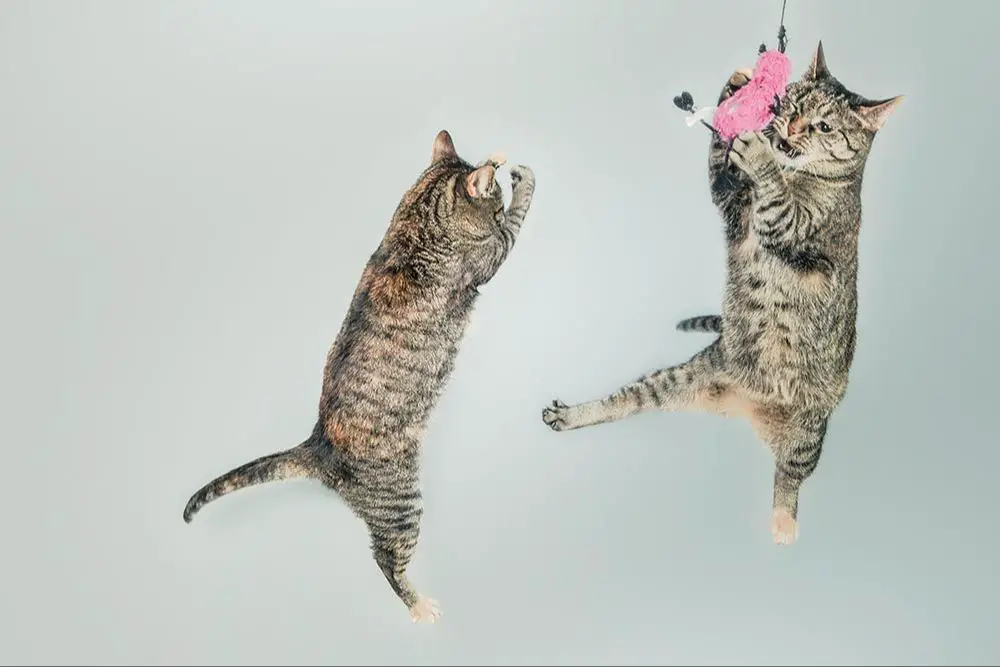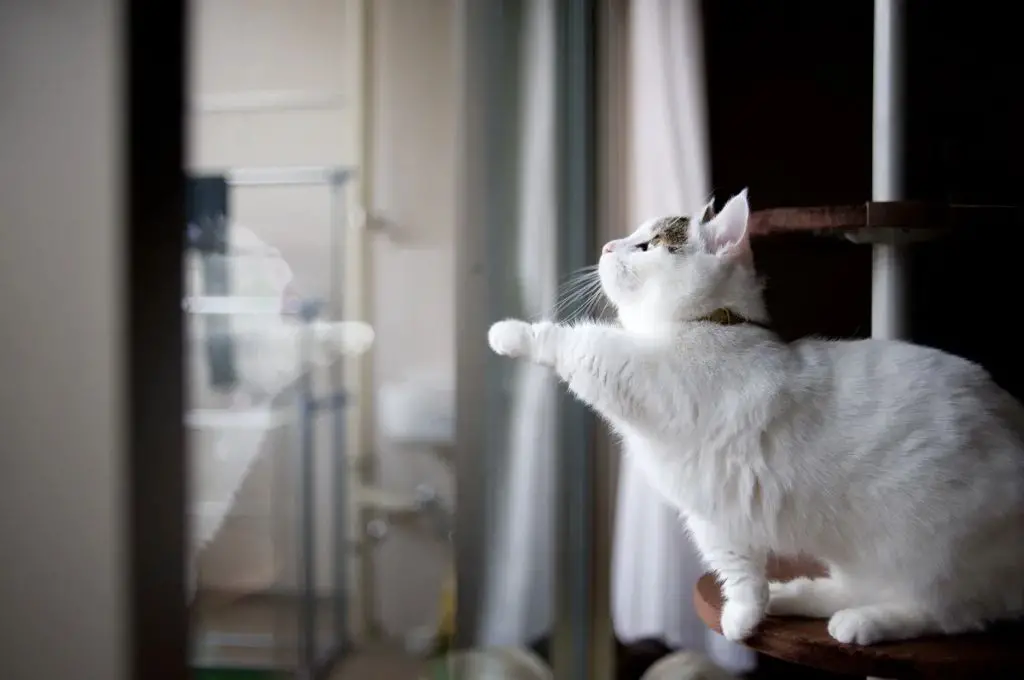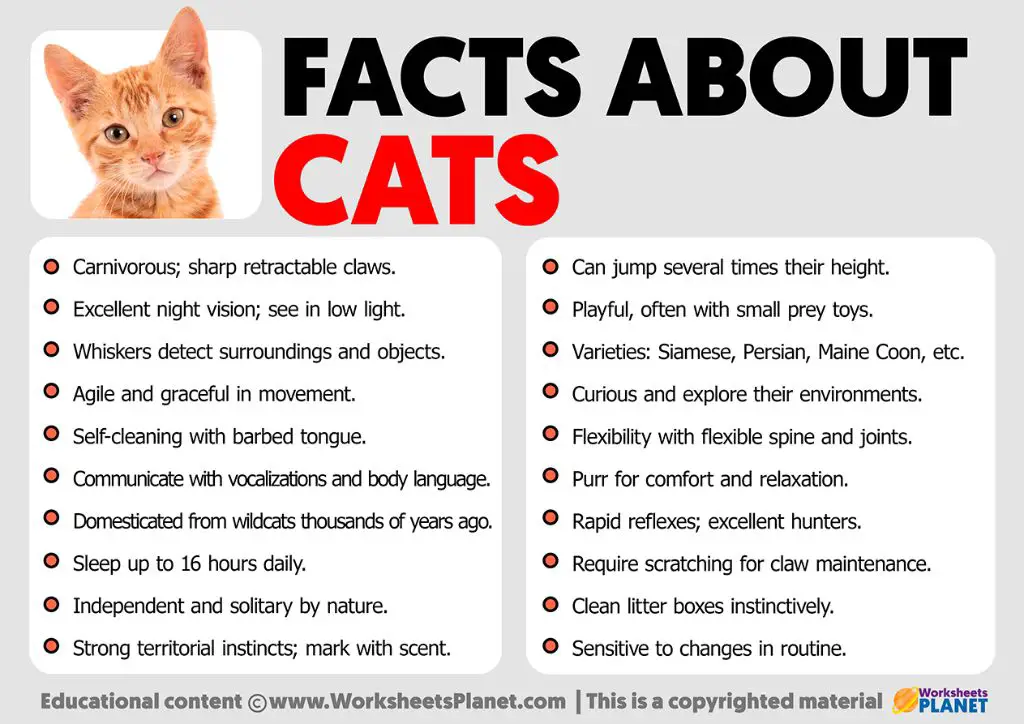Anatomy of a Cat’s Legs
Cats have very muscular hind legs that allow them to jump so high. Their thigh muscles are particularly large and powerful compared to other animals (1). This gives cats the ability to explosively contract their leg muscles and propel themselves upwards.
A cat’s leg bones are also important for jumping. They have a unique structure that provides flexibility and shock absorption. Their ankle joint can bend more than 180 degrees, and their toes can spread apart widely (2). This allows a cat to really push off and launch itself upwards when jumping.
Additionally, cats are digitigrade walkers, meaning they walk on their toes. This actually helps to increase their stride length and overall jumping capabilities (2). It essentially allows their legs to function like springs.
Sources:
(1) https://en.wikipedia.org/wiki/Cat_anatomy
(2) https://www.daviddarling.info/encyclopedia/C/cat_domestic_anatomy.html
Importance of Flexibility

Cats’ ability to jump high is due in large part to their extreme flexibility, especially in their spines. Cats have 5-7 more vertebrae in their spines than humans, allowing for greater extension and arching (Cornell). Their vertebrae are connected by very elastic ligaments that allow the spine to extend back and up during a jump. Additionally, the muscles connected to the spine are also extremely flexible, further enabling spinal extension and coiling (Catonsville Cat Clinic). This flexibility gives cats the ability to arch their backs and coil their spines to produce more power and height when jumping up or leaping through the air.
Low Body Weight
Cats have lightweight bodies with very little body fat compared to many other mammals. This allows them to propel themselves powerfully upward and reach impressive heights. The average healthy cat weighs only 8-12 pounds (PetMD). Lean muscle tissue makes up most of their body mass, while body fat is extremely low. This lack of heavy fat stores enables cats to spring up with their powerful leg muscles unencumbered. Their light frame also reduces the work their muscles need to do to launch the body upward. The smaller the body size, the higher cats can jump relative to their size. For example, a 10 pound cat can leap about 5-7 times their height, while larger cats may only jump 3-4 times their height. The incredible leaping ability of cats is aided by their unique anatomy and low overall body weight.
Fast-Twitch Muscles
Cats have a high proportion of fast-twitch muscle fibers, which allow their muscles to contract faster and more powerfully compared to other animals (Maxwell, 1977). Up to 80% of the fibers in cat leg muscles are classified as fast-twitch, versus only 50% in dog leg muscles (Maxwell, 1977). Fast-twitch fibers generate explosive strength, enabling cats to leap high and run fast in short bursts.
When preparing to jump, cats activate these fast-twitch muscles to propel themselves upwards with significant force. Researchers have found that long-term electrical stimulation of cat fast-twitch muscles increases their speed and power even further, as the muscles adapt to repeated usage (Al-Amood, 1973). This combination of innate and adaptable fast-twitch muscle allows cats to jump to impressive heights.
Technique
Cats use a specific technique when jumping that allows them to leap so high. They start by crouching down on their hind legs, engaging their powerful thigh muscles. Then they rock back slightly onto their haunches before exploding upwards and forwards, pushing off forcefully with their back legs (1).

As cats launch themselves into the air, they arch their spine and stretch out their front legs ready to land. This aerodynamic posture allows them to maximize height and distance. Cats can control the extension and flexion of their spine mid-air thanks to added thoracic vertebrae that provide flexibility (1). The arched back position enables their center of gravity to stay in alignment as they soar upwards.
Cats use this crouch, rock back, extend and stretch jumping technique to achieve impressive vertical heights. Their strong back legs, flexible spine, and aerodynamic posture are key to their gravity-defying abilities.
Height and Distance
Cats are remarkable jumpers, both vertically and horizontally. The highest recorded vertical jump for a domestic cat is approximately 7 feet, set by Waffles the cat according to the Guinness World Records. Waffles jumped onto a wall that was 213 cm or just over 7 feet tall.
For horizontal jumping, the record is held by Alley the cat who jumped an incredible 8 feet or 2.4 meters in a single bound according to Catster. This remarkable feat shows just how far cats can propel themselves forward from a standstill position.
While these record holders show the upper limits, most domestic cats can comfortably jump vertically about 6 feet high when extending their back legs. Horizontally, average cats can jump 5-6 feet in a single bound.
Breed Differences
Some cat breeds are naturally better jumpers than others. This is often due to their body type, muscle structure, and energy levels. According to Petozy, breeds known for their jumping ability include:

- Abyssinian
- Somali
- Bengal
- Savannah
- Manx
- Siamese
- Ocicat
These breeds tend to have lean, athletic builds and are very active and playful. The Abyssinian and Somali, for example, are known for their curiosity and agility. The Bengal is an energetic cross between a domestic cat and an Asian leopard cat. The Savannah descends from African servals, which are also great jumpers. While all cats can jump to some degree, these breeds stand out in their vertical leaping ability.
Training
Cats can be trained to improve their jumping ability through targeted exercises. One popular training technique is teaching cats to jump through hoops. According to VetStreet, start by holding the hoop just a couple inches off the ground and reward with treats when they jump through. Slowly increase the height over multiple training sessions until they can comfortably clear the hoop at their maximum jump height.
Other agility training like weave poles, tunnels, and obstacle courses can build muscle strength and flexibility. Consistent practice and incremental increases in difficulty help cats improve their jumping technique and ability over time. Clicker training is very effective for reinforcing desired behaviors like jumping on command. While genetics play a key role, proper training allows cats to maximize their natural jumping abilities.
Health Considerations
While jumping high comes naturally to cats, pet owners should still be aware of the potential health impacts for kitties who jump frequently or from great heights. According to veterinarians, jumping too much or from tall heights can stress cat joints, especially as cats age (reference 1). Impact from landing can put pressure on joints and potentially lead to issues like arthritis over time. Owners of senior cats or cats with pre-existing joint problems should take extra precautions by limiting access to tall furniture and cat trees.
However, for young and healthy cats, jumping and leaping is an important part of staying fit, provided they are landing on soft surfaces that absorb impact. As referenced in source 2, a 2-year-old cat jumping and twisting in moderation is perfectly normal and healthy. Kittens especially benefit from jumping playtime. Jumping helps strengthen leg muscles, promotes flexibility, and builds stamina. Unless directed by a vet for medical reasons, most cats should be allowed to jump and play freely. Monitoring cats when leaping from very high places can help prevent potential falls and injuries.
Fun Facts
Cats can reach incredible heights when jumping. The highest jump on record for a domestic cat is over 8 feet high! According to Guinness World Records, a cat named Lewis reached a height of 3.5 meters (11 feet 5.7 inches) in a jump in 2001. That’s taller than a basketball hoop!

Cats are adapted for jumping to great heights. Their anatomy gives them an advantage with strong hind legs, flexible spines, and low body fat. A healthy cat can jump 5-6 times their own body length vertically and horizontally [1]. For example, a 10 pound cat with a 20 inch body length could theoretically jump 10-12 feet high!
Kittens start developing their jumping skills around 2 weeks old. They playfully hop and jump to build strength. Kittens can jump their own height by about 26 days old and will reach their peak jumping ability by 1 year old [2].

